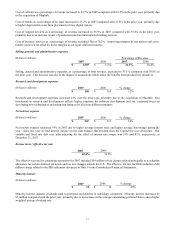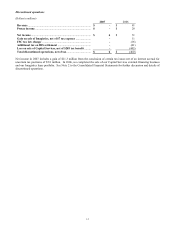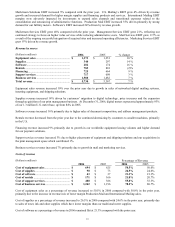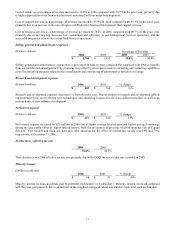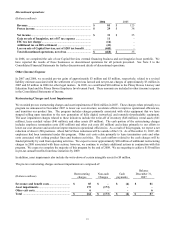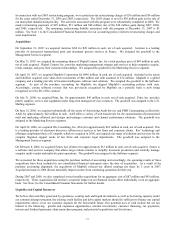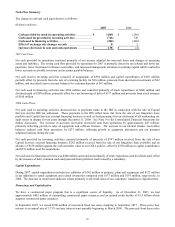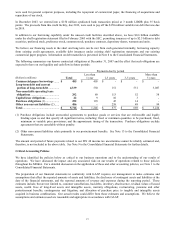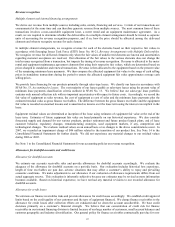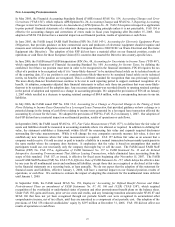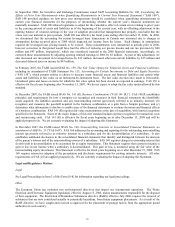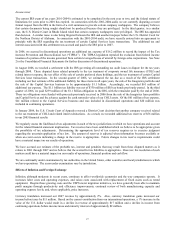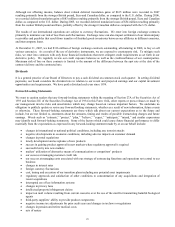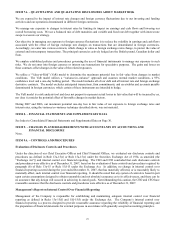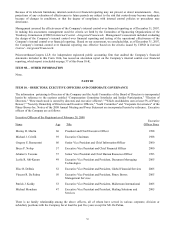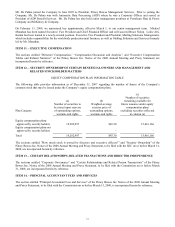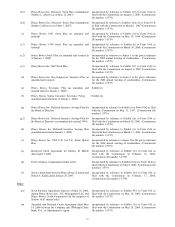Pitney Bowes 2007 Annual Report Download - page 41
Download and view the complete annual report
Please find page 41 of the 2007 Pitney Bowes annual report below. You can navigate through the pages in the report by either clicking on the pages listed below, or by using the keyword search tool below to find specific information within the annual report.23
120 days is to discontinue revenue recognition. We resume revenue recognition when payments reduce the account to 60
days or less past due.
We evaluate the adequacy of allowance for credit losses on a periodic basis. Our evaluation includes historical loss
experience, the nature and volume of our portfolios, adverse situations that may affect a customer’ s ability to repay, estimated
value of any underlying collateral and prevailing economic conditions. We make adjustments to our allowance for credit
losses if the evaluation of reserve requirements differs from the actual aggregate reserve. This evaluation is inherently
subjective because our estimates may be revised as more information becomes available.
Accounting for income taxes
We are subject to income taxes in the U.S. and numerous foreign jurisdictions. When we prepare our consolidated financial
statements, we are required to estimate our income taxes in each of the jurisdictions in which we operate. We record this
amount as a provision for our taxes in accordance with SFAS No. 109, Accounting for Income Taxes.
In June 2006, the Financial Accounting Standards Board issued FASB Interpretation (FIN) No. 48, Accounting for
Uncertainty in Income Taxes (“FIN 48”), which supplements Statement of Financial Accounting Standard No. 109,
Accounting for Income Taxes, by defining the confidence level that a tax position must meet in order to be recognized in the
financial statements. FIN 48 requires a two-step approach under which the tax effect of a position is recognized only if it is
“more-likely-than-not” to be sustained and the amount of the tax benefit recognized is equal to the largest tax benefit that is
greater than 50 percent likely of being realized upon ultimate settlement of the tax position. This is a different standard for
recognition than the approach previously required. Both approaches require us to exercise considerable judgment and
estimates are inherent in both processes.
We regularly assess the likelihood of tax adjustments in each of the tax jurisdictions in which we operate and account for the
related financial statement implications. We have established tax reserves which we believe to be appropriate given the
possibility of tax adjustments. Determining the appropriate level of tax reserves requires us to exercise judgment regarding
the uncertain application of tax law. We adjust the amount of reserves when information becomes available or when an event
occurs indicating a change in the reserve is appropriate. Future changes in tax reserve requirements could have a material
impact on our results of operations.
Based on our 2007 income from continuing operations before income taxes and minority interest, a 1% change in our
effective tax rate would impact income from continuing operations by approximately $7 million.
Long-lived assets
Useful lives of long-lived assets
We depreciate property, plant and equipment and rental property and equipment principally using the straight-line method
over estimated useful lives: machinery and equipment principally 3 to 15 years and buildings up to 50 years. We depreciate
other depreciable assets using either the straight-line method or accelerated methods. We amortize properties leased under
capital leases on a straight-line basis over the primary lease terms. We amortize capitalized costs related to internally
developed software using the straight-line method over the estimated useful life, which is principally 3 to 10 years.
Intangible assets with finite lives are amortized over their estimated useful lives, which are principally 4 to 15 years. Our
estimates of useful lives could be affected by changes in regulatory provisions, technology or business plans.
Impairment review
We evaluate the recoverability of our long-lived assets, including goodwill and intangible assets, on an annual basis or as
circumstances warrant. Our goodwill impairment review requires judgment, including the identification of reporting units,
assigning assets and liabilities to reporting units, assigning goodwill to reporting units and determining the fair value of each
reporting unit. Significant judgments required to estimate the fair value of reporting units include estimating future cash
flows, determining appropriate discount rates and other assumptions. We use internal discounted cash flow estimates, quoted
market prices when available and appraisals as appropriate to determine fair value. We derive the cash flow estimates from
our historical experience and our future long-term business plans and apply an appropriate discount rate. When available and
as appropriate, we use comparative market multiples to corroborate discounted cash flow results. Changes in these estimates
and assumptions could materially affect the determination of fair value and/or goodwill impairment for each reporting unit.


